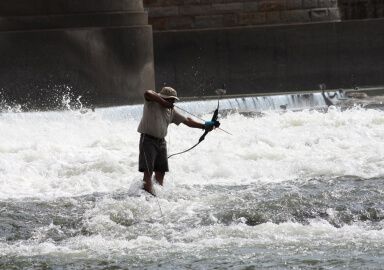Skate
Skates are a large group of bottom-loving, cartilaginous fish of many of the cooler water marine areas of our oceans.
View 4 listings
4
listings
–
price starting from
3
countries
–
to the nearest trip
Where and When?
Skate species are to be found in most of the cold, cool and temperate ocean waters and there is one freshwater species. Many are important in commercial fisheries and some species, such as the little skate, (Leucoraja erinacea), that is found off the north-east coast of the USA, are occasionally caught by sport anglers, but are usually used as bait for other fishing activities. The common skate is distributed from northern Norway and Iceland south to Senegal in Africa. Their common depth range is reported as 30-1 000 m. (98-3 280 ft.).
The most important and best organized recreational angling destinations are to be found around the west coasts of Scotland, Ireland and Norway. There are many charter boats with skillful skippers in suitable ports such as Oban in Scotland. Skates are generally fish found on sandy bottoms where they often “wriggle” and become partially immersed in the sand. They can be caught throughout the year and it is often the weather or climate that dictates when it is safest and most comfortable to fish for them. Shore fishing is often best after dark, but, when boat fishing at great depths the time of day is not really important. There are generally no closed seasons for recreational skate fishing.
About Skate
Skates are small, medium or large flatfish of the family Rajidae, which contains 17 genera, and more than 150 species of skate. All skates are dull coloured- mostly browns and greys and sometimes mottled. They have tough, leathery skin, sometimes with ‘thorns'' or spikes. They belong to the so-called cartilaginous fish, which means they have cartilage instead of true bones and are related to rays and sharks.
The mouth of the skates, which usually contains many grinding teeth, is on the underside and spiracles, on the upper side, take in water that is forced out through gill slits next to the mouth. Their smallish eyes are on the upper, or dorsal, side and males have large “claspers” near the tail, which makes them easy to distinguish from females. Small and medium sized skate species are important in some commercial fisheries, but it is only really the large ones that appeal to recreational anglers. The most important recreational species, that dominates skate sport fishing, is the common skate, (Dipterus batis), which can attain 2.85 m. disc diameter (9 ft. 4 in.) and 113 kg. (249 lbs.).
All skates feed mostly on benthic (bottom living) invertebrates, but will also take fish on occasion. They are usually coastal fish, but some species can reach extreme depths. While usually not a shoaling species, there are places of greater abundance and also aggregations, from time to time, which probably relate to mating. Skates lay eggs, which differs them from rays, that usually produce live young.
How to Catch?
Common skate fishing from the shore is usually difficult and, as they prefer fairly deep water, there are few places where it can be consistently successful. As most shore fishing is carried on after dark and from steep and high cliffs, it can be a scary adventure needing much preparation and local knowledge. Extremely heavy equipment is critical in order to land a large skate at night over sharp rocks in rough seas. Boat fishing, on the other hand, is usually much easier, safer and more productive, but heavy tackle, and other heavy equipment is still essential.
Skates are often found in very deep water. Bottom fishing, slow drifting or “bottom bouncing” with natural baits are the most popular fishing methods. Clams, mussels or worms work well, and so does live or dead small fish. Fish fillets, using species like mackerel, are popular and squid is very useful as it usually stays on the hook for extended periods. Landing a big skate on a rocky outcrop at night can be an exhausting, but rewarding and satisfying, adrenaline pumping, experience of a lifetime.







